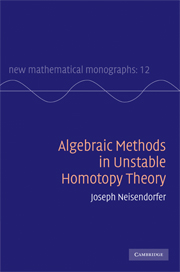Book contents
- Frontmatter
- Contents
- Preface
- Acknowledgments
- Introduction to unstable homotopy theory
- 1 Homotopy groups with coefficients
- 2 A general theory of localization
- 3 Fibre extensions of squares and the Peterson–Stein formula
- 4 Hilton–Hopf invariants and the EHP sequence
- 5 James–Hopf invariants and Toda–Hopf invariants
- 6 Samelson products
- 7 Bockstein spectral sequences
- 8 Lie algebras and universal enveloping algebras
- 9 Applications of graded Lie algebras
- 10 Differential homological algebra
- 11 Odd primary exponent theorems
- 12 Differential homological algebra of classifying spaces
- Bibliography
- Index
10 - Differential homological algebra
Published online by Cambridge University Press: 03 May 2010
- Frontmatter
- Contents
- Preface
- Acknowledgments
- Introduction to unstable homotopy theory
- 1 Homotopy groups with coefficients
- 2 A general theory of localization
- 3 Fibre extensions of squares and the Peterson–Stein formula
- 4 Hilton–Hopf invariants and the EHP sequence
- 5 James–Hopf invariants and Toda–Hopf invariants
- 6 Samelson products
- 7 Bockstein spectral sequences
- 8 Lie algebras and universal enveloping algebras
- 9 Applications of graded Lie algebras
- 10 Differential homological algebra
- 11 Odd primary exponent theorems
- 12 Differential homological algebra of classifying spaces
- Bibliography
- Index
Summary
Differential homological algebra is used in algebraic topology to study the homology of fibrations. The Serre spectral sequence determines the homology of the total space given the homologies of the base and fibre. In general, given the homologies of two out of the three, base, fibre, and total space, various techniques have been developed to determine the homology of the third.
Two cases of historical interest are the following: (1) Given the homology of a space, determine the homology of the loop space. (2) Given the homology of a topological group, determine the homology of the classifying space. In a real sense, these problems are dual to one another and have specific solutions.
The problem of determining the homology of the loop space is solved with the help of the cobar construction introduced by Frank Adams. This differential algebra, when applied to the chains on a space, is homologically equivalent to the chains on the loop space together with the multiplication induced by loop multiplication.
The problem of determining the homology of the classifying space is solved with the help of the bar construction introduced by Eilenberg and MacLane and followed up in a geometric form by John Milnor. This differential coalgebra, when applied to the chains on a topological group, is homologically equivalent to the chains on the classifying space together with the coalgebra structure given by the diagonal.
- Type
- Chapter
- Information
- Algebraic Methods in Unstable Homotopy Theory , pp. 313 - 436Publisher: Cambridge University PressPrint publication year: 2010



